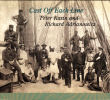List of Songs
SHENANDOAH
Lead: Richard

| Back to List of Songs |
SHENANDOAHLead: Richard |
 |
Another cargo-loading shanty with verses reflecting the love of Shenandoah as a geographical location.
LYRICS:
Oh, Shenandoah, my bully boys, how I long to hear you
Chorus: Way ay, ay-ay-ay, Shenandoah
Oh, Shenandoah, my bully boys, how I long to hear you
Chorus: Way ay, ay, ay, Shenandoah
Oh, Shenandoah, my bully boys, I took myself a notion
Oh, Shenandoah, my bully boys, to sail the stormy ocean
Oh, Shenandoah, my bully boys, I'm bound away to leave you
Oh, Shenandoah, my bully boys, I will not deceive you
Oh, Shenandoah, my bully boys, how I love yer daughters
Oh, Shenandoah, I love to hear the music of yer waters
'Tis seven years, oh Shenandoah, since I last seen you
Oh, Shenandoah, my bully boys, I will never grieve you
Oh, Shenandoah, my bully boys, she's my native valley
Oh, Shenandoah, beside her waters I do love to dally
Oh, Shenandoah, my bully boys, she's a lovely river
Oh, Shenandoah, my bully boys, I never will forget you
A cargo-loading shanty that was not in common use aboard ship. It was not uncommon for a shantyman to hear a song he liked and then sing that melody to a different set of words so I felt entirely justified in marrying a melody to Shenandoah found in F.T. Bullen's Songs of Sea Labour to the verses from a version found in Stan Hugill's Shanties from the Seven Seas (page 176 of the hard cover edition). Bullen states that he "heard it sung by Negroes heaving at the winches when working cargo in Georgetown, Demerara."
The verses used reflect the love of Shenandoah as a geographical location. Of this version Captain F. Shaw, in his Splendor of the Seas, writes " the Shenandoah River flowed through the slave states below the Mason and Dixon Line and whoever sang it first was obviously pining for the delights of that considerable stream " Another point about this shanty is the fact that no two shantymen ever sang the same pronunciation of the word "Shenandoah". Shenandoar, Shannadore, Shanidah and Shangadore were all used. Bullen gives the word as "Shenandoh" and that is the pronunciation we use in our recording.
The more famous version of Shenandoah, the one about an Indian chief, was one of the most popular of all capstan and windlass shanties. Collector William M. Doerflinger says that the chief's name was Skenandoah and he was of the Oneida tribe, and he also writes that the song was an old cavalry one known as The Wild Mizzourye. Captain W.B. Whall, another collector, says it used to figure in old school collections and believes it to have belonged originally to the American or Canadian voyageurs. Others think it came from the 'mountain men' or traders of the early West. Hugill also thinks that it may have been nothing more than a river-song one of the songs used by boatmen of the great American rivers (like the Ohio). There is a very popular Ohio boatman-song Dance the Boatman, Dance that became a deep-water shanty, and The Hog-eye Man is another one originating with river men. Alan Lomax gives a "cavalry version" that he calls The Wild Mizzourye:
For seven long years I courted Nancy.
Chorus: Hi, oh, the rolling river
She would not have me for a lover.
Chorus: Ho, ho, I'm bound away for the wild Mizzourye!
And so she took my fifteen dollars.And then she went to Kansas City.
And there she had a little sh-sh baby.
She must have had another lover.
He must have been a th Cavalry Soldier.
I'm drinking rum and chawin' tobacco.
I learnt this song from Tommy Tompkins.